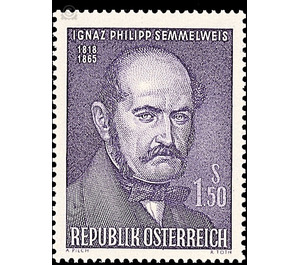100th anniversary of death - Austria / II. Republic of Austria 1965 - 1.50 Shilling
Theme: Health & Human
| Country | Austria / II. Republic of Austria |
| Issue Date | 1965 |
| Face Value | 1.50 |
| Color | violet |
| Printing Type | Typography |
| Stamp Type | Commemorative |
| Item Type | Stamp |
| Chronological Issue Number | 535 |
| Chronological Chapter | OOS-OE2 |
| SID | 30138 |
| In 69 Wishlists | |
As Dr. Ignaz Philipp Semmelweis began his work at the First Inpatient Clinic in Vienna in March 1847, and in some months up to 30 out of 100 women who had recently died died of childbirth fever. At the Secondary Bearing Clinic in Vienna, where only midwives were trained, mortality was less than a third of that. Semmelweis found a way to solve this puzzle - through precise methodology of thinking, a hallmark of the later world famous second Viennese medical school. The first Gebärklinik served exclusively for the education of the students. After the dissection exercises, the doctors and students touched the wombs with their hands infected with parts of the corpse. Semmelweis recognized this as the cause of childbed fever (pyemia or blood replacement) and introduced as a countermeasure the chlorine disinfection of the hands. The drastically reduced mortality rate proved him right. The "Savior of the Mothers", however, had to fight his life for the recognition of his method. Supported by the best of his Viennese colleagues, who at times led the fight for the talk-and-shy Semmelweis, he struggled to enforce his knowledge. Without being able to experience this, on August 13, 1865, at the age of 47, he died of the same disease for which he had done so much - a blood poisoning. The brand image shows a portrait of Ignaz Semmelweis.


